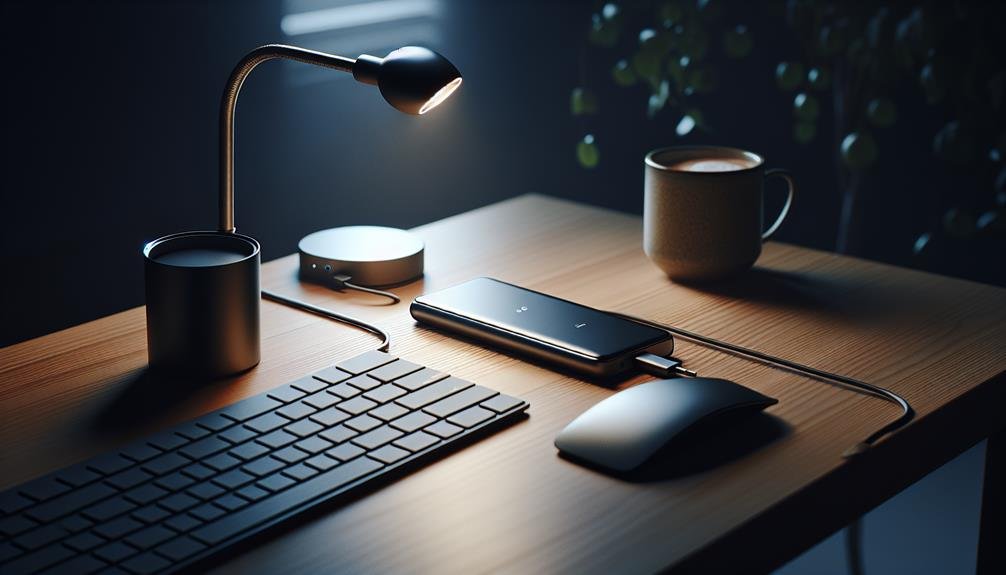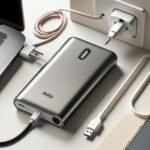Using a power bank to charge your iPhone is generally good, offering portability and continuous usage. However, quality is essential. Inconsistent power output from low-cost power banks can impact battery health, reducing lifespan. Make sure the power bank aligns with your iPhone's requirements, ideally supporting Apple's fast-charging standards. Always use high-quality, certified cables. Be vigilant for overcharging risks, potential overheating, and ensure your power bank has safety features like overcharge protection and stable voltage output. Balanced capacity and output power in a compact design will maximize efficiency and safety. There's more to ponder for ideal charging practices.
Benefits of Using Power Banks
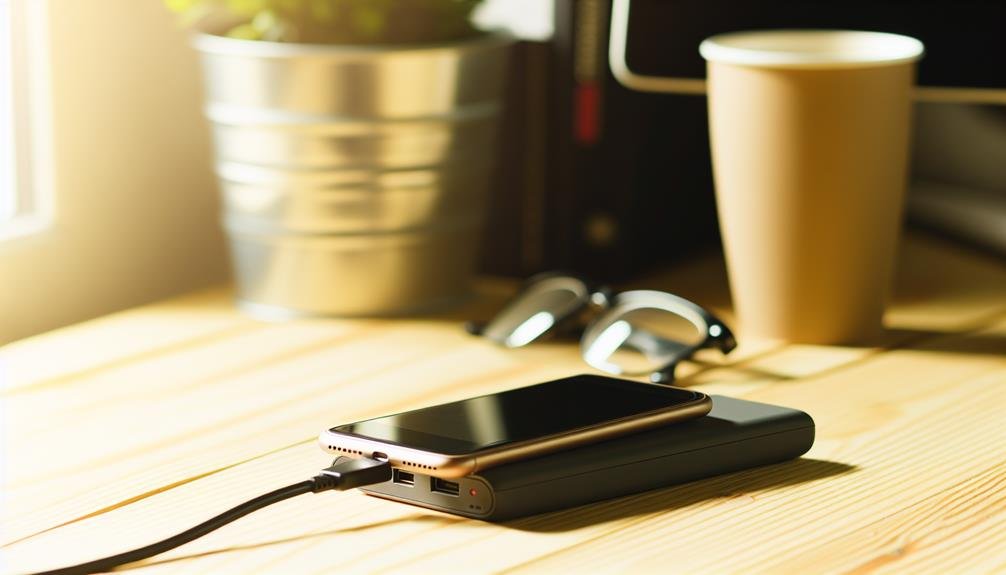
One of the primary benefits of using power banks is their ability to provide portable, on-the-go charging solutions for your iPhone, guaranteeing uninterrupted device usage even in locations without access to electrical outlets. This feature is particularly advantageous during emergencies, where having a charged phone is essential for safety and communication. Power banks offer the convenience of emergency charging, allowing you to maintain connectivity and access essential information regardless of your environment.
In addition, power banks serve as a reliable source of backup power, which is crucial for travel. Whether you're on a long flight, camping in remote areas, or simply on a business trip, the ability to recharge your iPhone without depending on traditional power sources can be a significant advantage. The compact design of modern power banks makes them easy to carry, further enhancing their role as a travel essential.
Moreover, many power banks come equipped with multiple USB ports, enabling the simultaneous charging of multiple devices. This multi-port functionality guarantees that you can keep your iPhone and other essential gadgets powered up, reducing the risk of being caught without a functioning device when you need it most.
Potential Downsides
When using a power bank to charge your iPhone, you might encounter several potential downsides. These include the impact on battery health due to inconsistent power output, variations in charging speed, and the quality of the power bank itself. It's important to take these factors into account to guarantee the longevity and efficiency of your device.
Battery Health Impact
Charging your iPhone with a power bank can potentially impact battery health due to factors like inconsistent power delivery and heat generation. Frequent charging can lead to increased wear on the battery, reducing its longevity. Power banks often provide varying voltage and current levels, which may not always align with your iPhone's requirements. This variability can accelerate battery degradation over time.
Overcharging risks are another significant concern. Not all power banks are equipped with advanced circuitry to prevent overcharging, which can result in performance issues. Overcharging can cause the battery to overheat, potentially harming internal components and shortening its lifespan.
Consider the following factors:
| Factor | Impact on Battery Health |
|---|---|
| Charging Frequency | Regular charging can decrease battery longevity. |
| Power Delivery | Irregular power may cause uneven wear. |
| Overcharging Risks | Results in overheating and potential harm. |
| Heat Generation | Excessive heat can deteriorate battery cells. |
| Voltage Fluctuations | Can induce strain on battery components. |
To mitigate these risks, use a high-quality power bank with built-in safety features. Always monitor your device during charging to ensure it doesn't overheat. Prioritizing battery health can help maintain your iPhone's performance and longevity.
Charging Speed Variations
Over time, the fluctuations in charging speeds provided by different power banks can have a negative impact on your iPhone's battery health. These disparities arise because not all power banks are made equal in terms of charging effectiveness and power distribution. While some power banks offer rapid charging capabilities, others may not be optimized for your iPhone's specific needs. This lack of power bank compatibility can lead to less than ideal charging conditions, thus impacting battery longevity.
When a power bank delivers inconsistent charging speeds, it can cause changes in the battery's internal temperature. High-speed charging can produce excess heat, which is harmful to the battery's overall lifespan. Conversely, slower charging speeds may extend the charging time, resulting in inefficiencies. Both situations highlight the significance of charging optimization tailored to your iPhone's specifications.
Ensuring that the power bank you use is suitable for your iPhone's charging protocol is essential for preserving battery health. Using a power bank with suitable charging effectiveness not only protects your device but also prolongs its operational lifespan. Hence, it's important to take into account the technical specifications and compatibility before using a power bank to charge your iPhone.
Power Bank Quality
Evaluating power bank quality is crucial, as inferior components and construction can lead to several potential downsides that adversely affect your iPhone's performance and battery health. Low-grade power banks often exhibit poor power bank efficiency, resulting in longer charging times and incomplete charging cycles. This inefficiency can strain your iPhone's battery, leading to diminished battery lifespan.
Moreover, substandard power banks may lack essential safety features, posing risks such as overcharging, overheating, and short-circuiting. These issues compromise charging safety and can cause permanent damage to your device. Not all power banks are created equal, and understanding the nuances in their quality can help you make an informed decision.
| Quality Aspect | Potential Downsides |
|---|---|
| Poor Component Quality | Reduced efficiency, longer charging times |
| Lack of Safety Mechanisms | Overcharging, overheating risks |
| Inconsistent Output | Fluctuations damaging iPhone battery |
| Subpar Construction | Increased likelihood of short-circuiting |
Additionally, inconsistent power output from low-quality power banks can lead to fluctuations in charging speed and voltage, further stressing your iPhone's battery. Always prioritize power banks with high efficiency and robust safety features to ensure peak performance and longevity for your device. Remember, investing in a high-quality power bank is a proactive step towards safeguarding your iPhone's battery health and overall functionality.
Impact on Battery Health
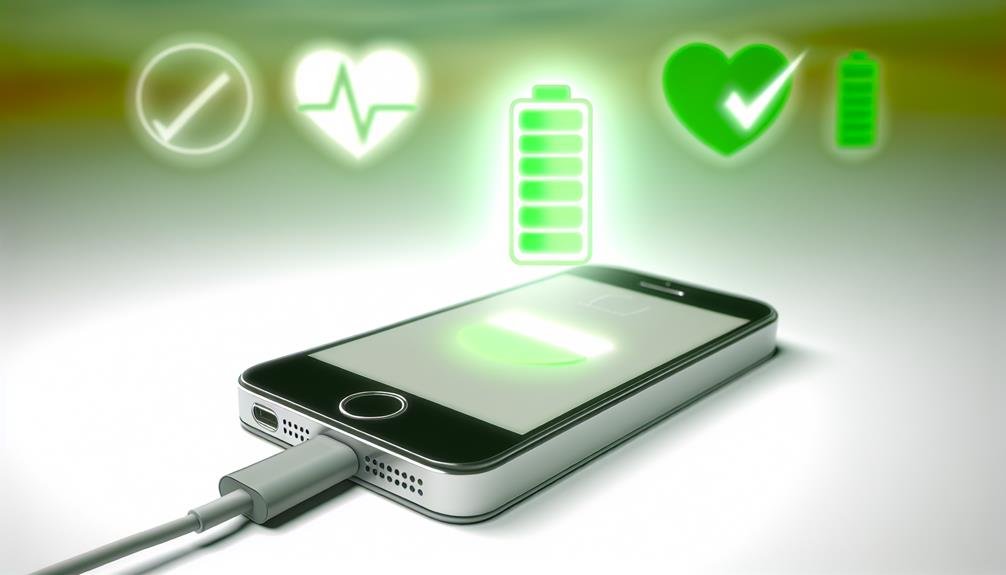
The use of a power bank to charge your iPhone can potentially impact battery health due to factors such as output voltage stability and heat regulation. Battery longevity is influenced by charging habits, and making sure you use a power bank that maintains a stable voltage output is essential. Unstable voltage can cause fluctuations that stress the battery, potentially leading to quicker degradation.
Power bank compatibility plays a significant role in maintaining your iPhone's battery health. Not all power banks are designed to work seamlessly with iPhone batteries. Using a power bank that is not specifically compatible can result in improper charging cycles and overheating, which in turn can shorten the battery's lifespan. Always verify that the power bank you choose is certified to work with your iPhone model to avoid these issues.
Heat management is another important factor. Charging generates heat, and excessive heat can damage your battery over time. Quality power banks come with built-in heat management systems to regulate temperature and prevent overheating. By selecting a power bank with these features, you'll ensure your iPhone's battery remains in its best condition for as long as possible.
Charging Speed Considerations
When considering charging speed, it's vital to grasp how different power bank specifications can influence the rate at which your iPhone recharges. Certain factors like output power, charging protocols, and cable quality play key roles in determining the efficiency and safety of the charging process.
Compatibility issues arise when the power bank's output voltage and current don't match the iPhone's requirements. This can lead to subpar charging speeds or even potential damage to your device. Hence, always check the power bank's specifications to confirm they align with your iPhone's charging needs.
Efficiency concerns also come into play. Using a power bank with fast-charging capabilities can greatly reduce the time needed to recharge your iPhone. However, it is crucial to verify that the fast-charging protocol is compatible with your device to avoid unnecessary wear and tear on the battery, which can impact battery longevity.
- Output Power: Confirm the power bank has the suitable wattage for your iPhone.
- Charging Protocols: Validate compatibility with fast-charging standards like Apple's 18W USB-C Power Delivery.
- Cable Quality: Utilize high-quality cables to uphold optimal charging speeds and ensure safety.
Understanding these factors can help you achieve peak charging while maintaining the longevity of your iPhone's battery.
Choosing the Right Power Bank
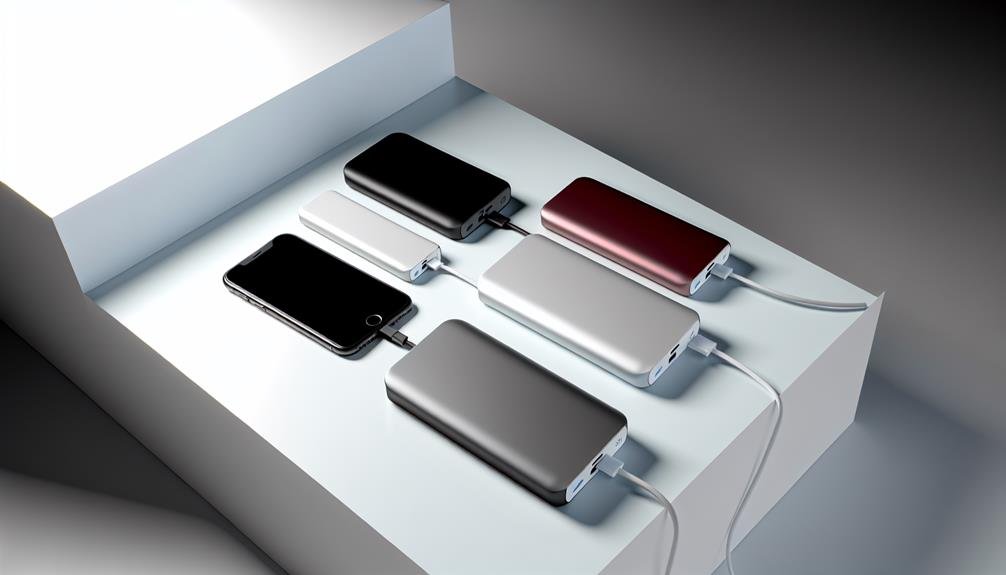
When selecting a power bank for your iPhone, you need to take into account both its capacity and output power to meet your charging requirements. Additionally, assess the portability and design to balance convenience with functionality. By analyzing these factors, you can make an informed decision that aligns with your usage patterns and mobility needs.
Capacity and Output Power
Selecting a power bank with the appropriate capacity and output power is necessary to guarantee your iPhone charges efficiently and safely. The capacity, measured in milliampere-hours (mAh), directly impacts how many times you can charge your iPhone before the power bank itself needs recharging. A higher capacity means more charges, but it's important to balance this with the power bank's output power.
Charging efficiency and battery longevity are two significant factors to take into account:
- Output Power (Wattage): Make sure the power bank's output matches your iPhone's charging requirements. Most modern iPhones support fast charging, requiring at least 18W of power. Using a power bank with insufficient output can result in slower charging times and potentially degrade your iPhone's battery over time.
- Capacity (mAh): For frequent travelers or heavy users, a power bank with 10,000 to 20,000 mAh is ideal. This guarantees multiple charges without compromising portability.
- Safety Features: Look for power banks with overcharge protection, temperature control, and short-circuit prevention. These features help maintain battery longevity and protect both your iPhone and the power bank from potential damage.
Portability and Design
To maximize portability and design, prioritize power banks that combine lightweight materials with a compact form factor without sacrificing charging efficiency. Look for size options that fit comfortably in your pocket or bag, ensuring you can carry them easily throughout the day. Color choices may seem superficial, but a bright or distinctive color can help you quickly locate your power bank in a busy environment, adding a layer of convenience.
Durability is another vital factor. Opt for power banks constructed with robust materials such as anodized aluminum or durable plastics, which can withstand daily wear and tear. These materials not only enhance longevity but also contribute to the overall safety of the device, reducing the risk of damage that could lead to malfunctions or hazardous situations.
Weight limitations are essential, particularly if you plan to carry the power bank during travel or extended periods. A lighter power bank will reduce strain and enhance portability without compromising on performance. Balancing these elements—size options, color choices, durability, and weight limitations—ensures you select a power bank that is both practical and reliable for safely charging your iPhone on the go.
Best Practices for Charging
Maintaining best battery health while using a power bank involves following specific charging guidelines and understanding the technical nuances of both your iPhone and the power bank's capabilities. Proper charging habits are crucial for preserving battery longevity and preventing potential safety issues. To optimize your charging experience, follow these best practices:
- Use certified cables and power banks: Always utilize MFi (Made for iPhone) certified cables and power banks to guarantee compatibility and safety. Non-certified accessories might not deliver the correct voltage, leading to overheating or battery damage.
- Avoid complete discharges: Lithium-ion batteries, such as those in iPhones, do not benefit from complete discharges. Ideally, maintain your battery level between 20% and 80% to extend its lifespan.
- Monitor charging temperatures: Both your iPhone and power bank should maintain a moderate temperature during charging. Excessive heat can deteriorate battery health over time, so refrain from charging in hot environments or direct sunlight.
Frequently Asked Questions
Can Power Banks Cause My Iphone to Overheat?
Think of your iPhone's battery health like a delicate ecosystem. If the power bank's charging speed is too high or inconsistent, it might cause overheating. Confirm the power bank's output matches your device's specifications for safe use.
Are Power Banks Safe to Use on Planes?
When flying, power banks are generally safe if they meet safety regulations. Guarantee the battery capacity doesn't exceed airline limits, typically 100Wh. Always keep them in your carry-on, as checked luggage restrictions apply.
How Do I Know if My Power Bank Is Compatible With My Iphone?
To guarantee compatibility between your power bank and iPhone, check the power bank features like output voltage and amperage. Verify the charging speed matches your iPhone's requirements, typically 5V/2.4A, to avoid potential damage and guarantee safety.
Can I Use My Iphone While It's Charging With a Power Bank?
You're burning the candle at both ends when multitasking while charging your iPhone with a power bank. Technically, it's safe, but be mindful of the battery life impact over time due to increased heat.
Do Power Banks Work With Other Apple Devices?
Yes, power bank compatibility extends to other Apple devices. Most modern power banks support Apple device charging, including iPads and AirPods. Confirm that the power bank provides the appropriate voltage and amperage to maintain safety and efficiency.

